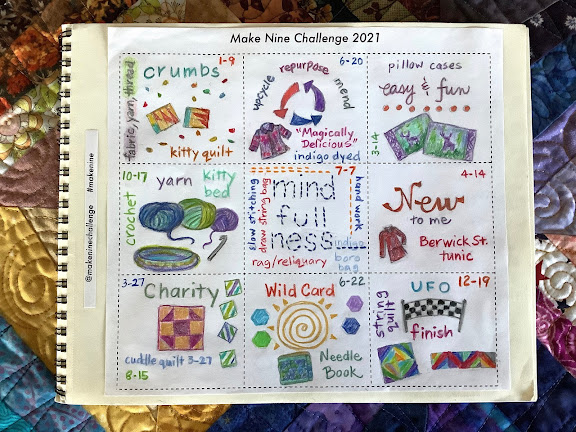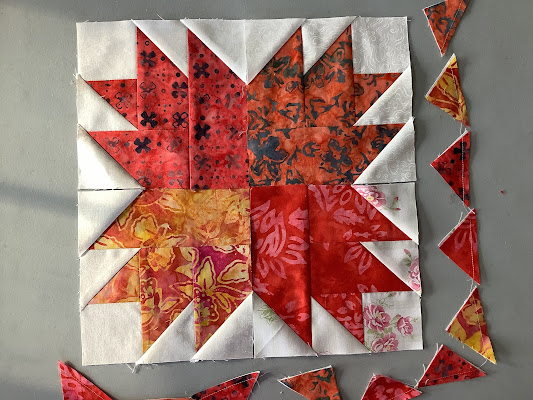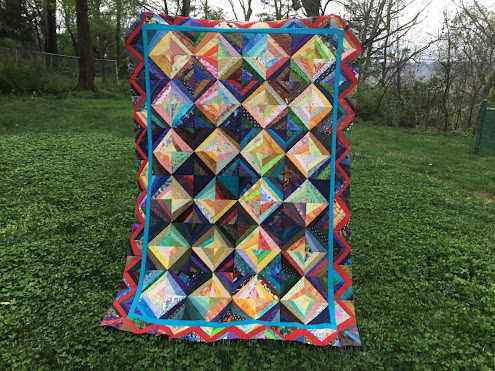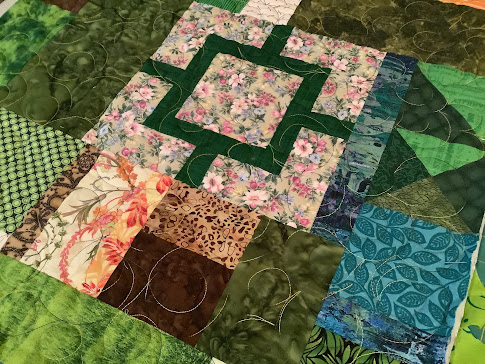2021 has come to an end and my Stitching Success Tracker was 100% colored in—meaning I did some kind of stitching, patchwork, quilting or related fiber art each and every day in 2021. Some days could be as little as a few embroidery stitches on a sampler or basting one 3/4" hexagon to the free-motion quilting marathon for this year's guild Challenge entry.
 |
| December 31, 2021: Stitching Success Tracker. |
I'm feeling good about the projects that were completed this year—some new, some unexpected and a few that were languishing in the UFO pile for quite some time (4 decades for one of them). The photo montages below tell about my year in fabrics and stitching.
Online Challenges keep me motivated
Motivation throughout the year was provided by several online Challenges I participated in. The 100 Day Project (I did two different practices), September Textile Love, 100 Days 100 Blocks, the Dropcloth Picnic Sampler stitch-along, Make Nine 2021 and a Quilting Success Bingo game issued by my local quilt guild.
 |
| Online Challenges: The 100 Day Project, Picnic Sampler stitch along, 100 Days 100 Blocks, September Textile Love and Quilting Bingo |
One of the successes from the September Textile Love Challenge was documenting a garment I'd made in 2015. The prompt was "repurpose" and my Tablecloth Jacket was the epitome of upcycling and repurposing. I'm glad to have this special garment documented.
Useful items for family, friends and community
The practical side of me likes to make things that someone not only appreciates, but uses. I made several sets of pillowcases for family and friends, charity quilts and kitty quilts for our pack of tuxedo kitties.
 |
| Pillow cases and charity quilts. |
Shop samples serve as inspiration to others
For my job as a fabric strategist and sales representative, I support my clients by providing ideas, projects and patterns that can be made with the fabrics I rep. Surprisingly, I made six quilts showcasing one of my favorite fabric lines, M&S Textiles Australia.
 |
| Quilts and projects made with fabrics from M&S Textiles Australia. |
My Guild Challenge entry
A two-year project that I'm quite proud of is my entry for the 2020-21 Choo Choo Quilters Guild Challenge. The turn-out for the Challenge was exceptional and my quilt, "Alone Together," got the first place ribbon. One of the principles of a guild Challenge is to push oneself and try new things. I did and was very pleased with the results. My experiments and discoveries are documented here.
 |
| "Alone Together" My entry in the 2020-21 Choo Choo Quilters Guild Challenge. |
I was also on the hosting committee for the Challenge and made the four award ribbons for the winning entries.
 |
| Guild Challenge ribbons. |
 |
| Guild Challenge ribbons (backs). |
Garments
It must have been the year for my Australia fabrics because two of my makes—my Kangaroo Nine Lives top and my new Berwick St. tunic—were made from this fabric line (top photos).
 |
| Garment highlights from 2021. |
The bottom two garments were both made during a Shakerag workshop. The Porcupine shirt was shibori dyed this year (a Make Nine project) and the Tablecloth Jacket was made in 2015 (a response to one of the prompts of the September Textile Love challenge this year).
A UFO quilt was finished!
My final Make Nine finish for the year was a UFO [unfinishing object] string quilt than spanned two centuries. It was happily gifted for Christmas.
 |
| "All Together Now" completed December 2021. |
Small projects are big successes
Small projects are very satisfying to me. The time investment can be less or more than a bigger project. You never know. Three of these were made in response to the Make Nine challenge, the zipper pouch was a gift for a friend who retired, and the exposed spine artist book was from a workshop I took this year with Doug Baulos. The fabric twine was a new technique I learned and it was rewarding to find a use for skinny fabric scraps and trimmings.
 |
| Top row: needle book, fabric twine, crochet cat bed. Bottom row: boro and rag drawstring bag, artist book, zipper pouch. |
All and all, I think 2021 was a productive and well-documented year.
Good night, and Happy New Year.
-----------
For those that asked about the Stitching Success Tracker and where to get this cool, creative project management tool, here is my original blog post and where I found this calendar.


































